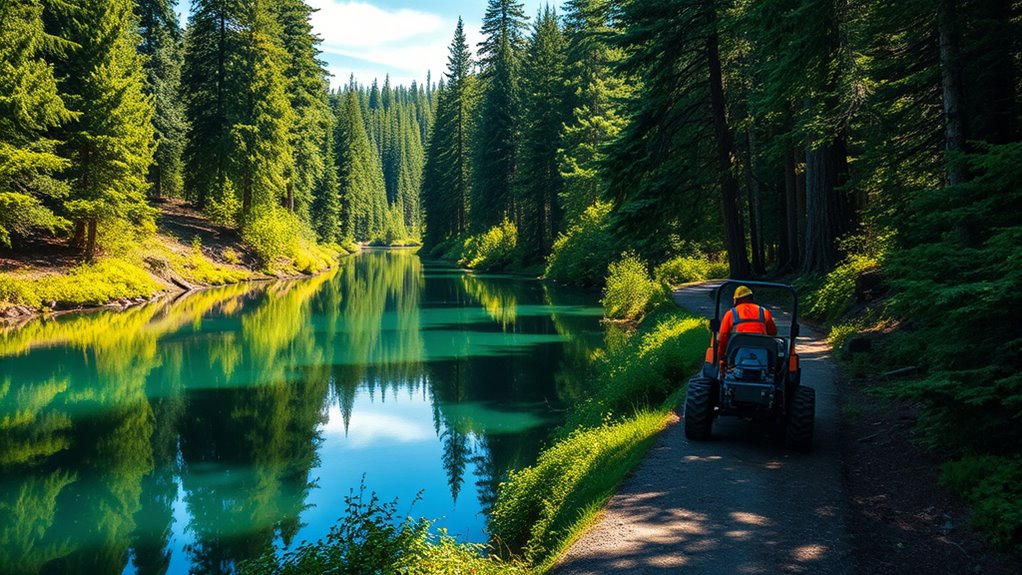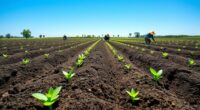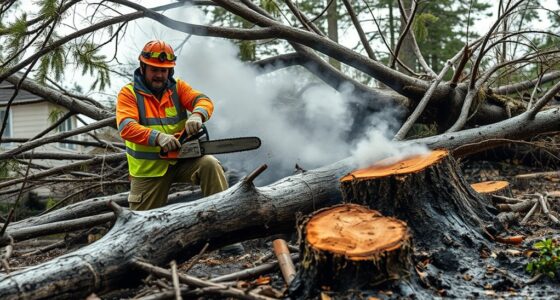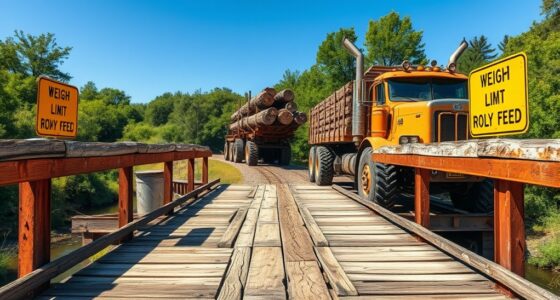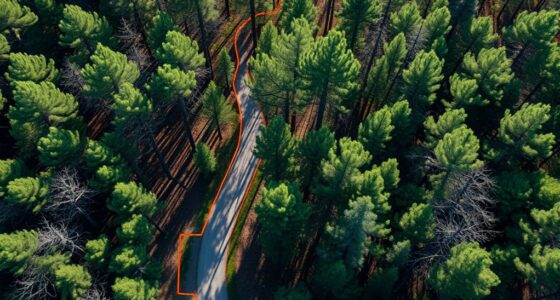To safeguard waterways while logging, start with an environmental risk assessment to identify potential pollution sources. Set up buffer zones with undisturbed vegetation along streams to filter runoff and prevent erosion. Use sustainable harvesting like selective logging to minimize habitat disruption, and implement erosion controls such as silt fences and contouring. Continuously monitor water quality and involve stakeholders to guarantee responsible practices. Follow these steps to reduce impacts and learn more about effective waterway protection.
Key Takeaways
- Establish buffer zones with undisturbed vegetation along waterways to filter runoff and reduce sediment entry.
- Implement erosion control measures like silt fences, contouring, and terracing to prevent soil erosion into water bodies.
- Use real-time water quality monitoring during logging to detect and address pollution or sedimentation early.
- Plan logging activities to avoid critical habitats, riparian zones, and ensure minimal disturbance to stream flow.
- Engage stakeholders and maintain open communication to develop responsible practices that protect waterways effectively.
Assessing Environmental Risks Before Logging
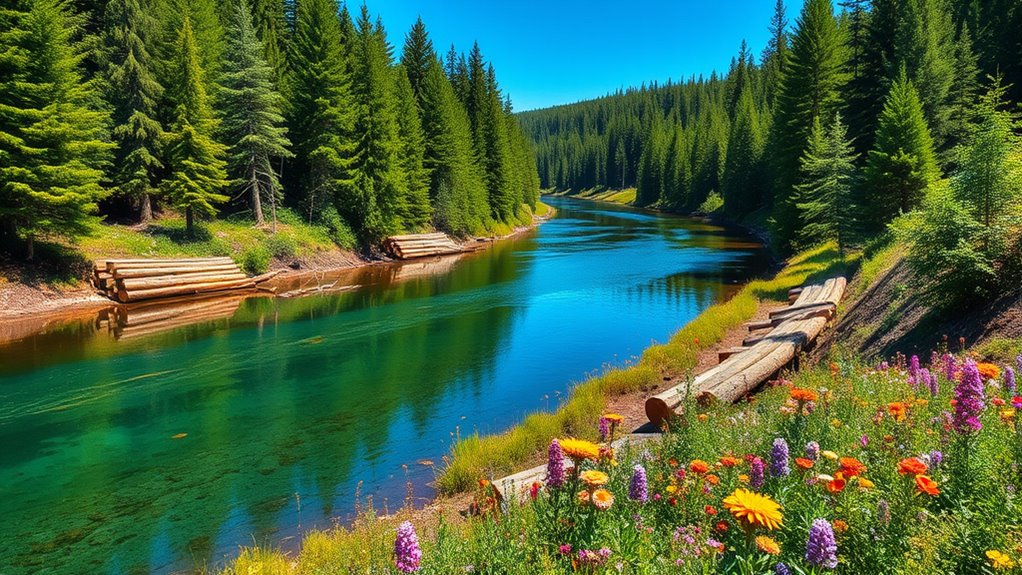
Before beginning logging activities near waterways, it’s crucial to thoroughly assess environmental risks to prevent harm to aquatic ecosystems. You need to identify potential sources of water pollution, such as runoff containing sediments, oils, or chemicals from machinery. Sediment runoff can smother aquatic habitats, disrupt fish spawning, and reduce water quality. Consider how logging operations might alter natural water flow, increase erosion, or introduce pollutants into nearby streams and rivers. By evaluating these risks beforehand, you can develop strategies to minimize impacts on aquatic habitats. Proper assessment helps you avoid unintended damage, ensuring that water quality remains healthy and ecosystems stay resilient. Incorporating environmental monitoring into your planning allows for early detection of potential issues and timely adjustments. Taking these proactive steps safeguards both the environment and your logging project’s sustainability.
Implementing Buffer Zones Along Waterways

Implementing buffer zones along waterways is a crucial practice to protect aquatic ecosystems from logging-related impacts. These zones act as barriers, filtering runoff and sediment that could harm aquatic vegetation and disrupt wildlife corridors. By maintaining a strip of undisturbed vegetation along streams and rivers, you help preserve vital habitats for fish, amphibians, and other aquatic species. Buffer zones also support terrestrial wildlife by providing safe corridors that connect habitats across the landscape. When establishing these zones, ensure they are wide enough to trap pollutants and reduce erosion. This approach minimizes the disturbance to Coolers and Freezers aquatic vegetation and safeguards the overall health of the waterway, promoting a balanced ecosystem that benefits both wildlife and the environment. Studies show that incorporating security measures can further enhance the protection of sensitive areas from unauthorized access or activities that could compromise the buffer zones. Additionally, understanding the importance of natural buffers can guide effective planning and management strategies to sustain these vital zones in the long term. Recognizing the role of natural buffers in ecosystems, many conservation efforts focus on maintaining and restoring these essential areas for long-term ecological health. Properly designed buffer zones can also serve as habitat corridors, facilitating wildlife movement and genetic exchange across fragmented landscapes.
Using Sustainable Harvesting Techniques
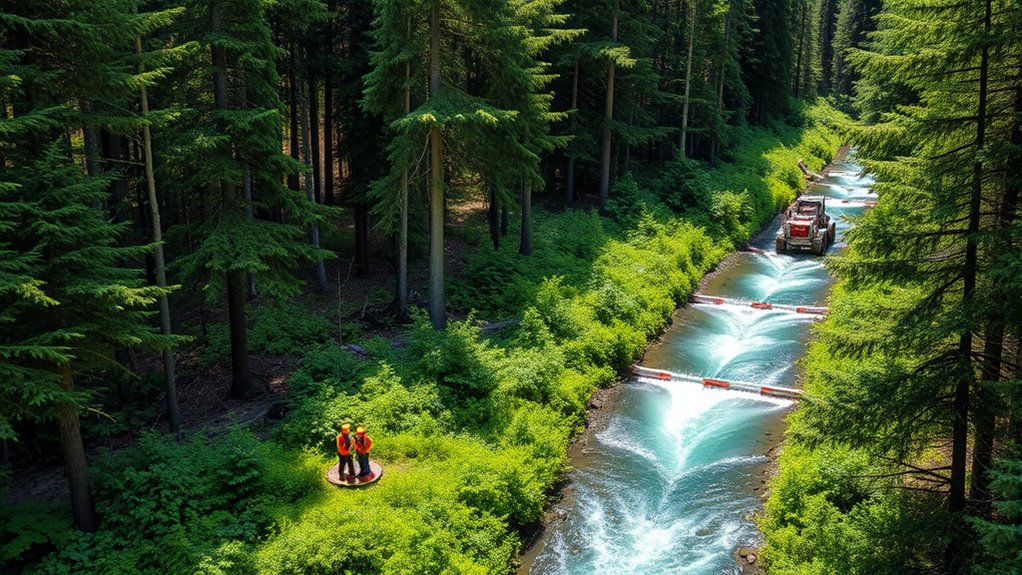
Using sustainable harvesting techniques is essential to guaranteeing the long-term health of waterway ecosystems while still meeting resource needs. You can minimize forest fragmentation by selectively logging and avoiding large clear-cut areas that disrupt wildlife corridors. This approach helps maintain connectivity for species that depend on continuous habitats. Additionally, planning harvests around critical wildlife corridors ensures animals can access food, water, and breeding sites without interruption. You should also consider leaving mature trees and riparian buffers intact to protect water quality and provide shelter. Incorporating these practices reduces sediment runoff and preserves biodiversity, ultimately supporting healthier waterways. Understanding behavioral patterns of local wildlife can further optimize sustainable harvesting efforts. Implementing adaptive management strategies allows for ongoing assessment and adjustment of practices to ensure ecological balance. Engaging in collaborative planning with conservation experts can enhance the effectiveness of these strategies. Utilizing ecosystem-based management approaches ensures that ecological processes are maintained during harvesting activities. By focusing on sustainable methods, you balance economic benefits with ecological integrity, securing waterway protection for future generations. Additionally, monitoring long-term ecological impacts helps identify potential issues early and adapt practices accordingly.
Managing Erosion and Runoff Effectively
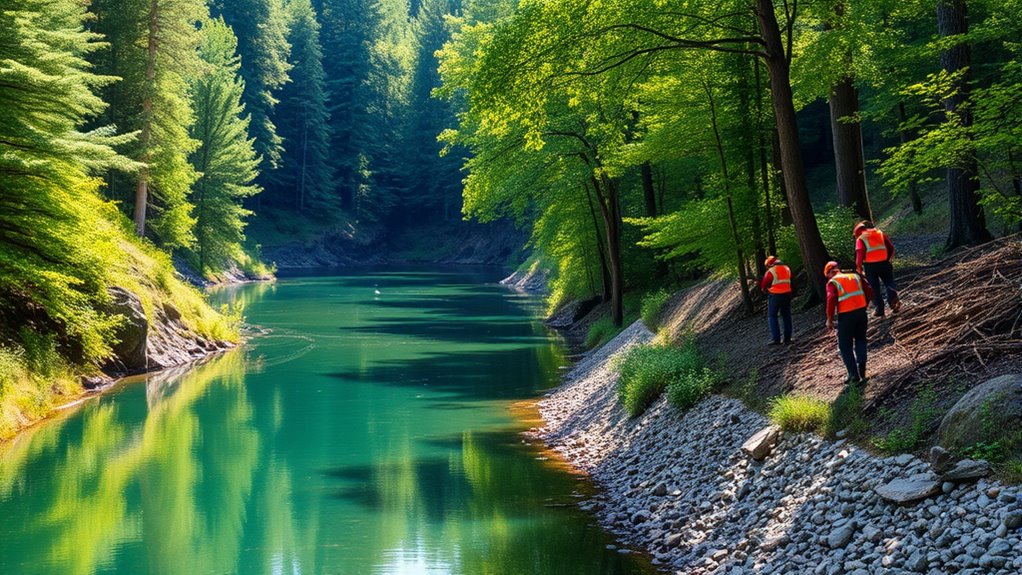
To protect waterways, you need to implement effective erosion control techniques and runoff management strategies. These methods help prevent soil loss and reduce pollutants entering water systems. Implementing vertical storage solutions by using contouring and terracing can further minimize runoff velocity and soil disturbance. Additionally, understanding soil stability is essential for maintaining erosion control measures and ensuring long-term water protection. By actively managing these issues, you can safeguard water quality and promote healthier ecosystems. Incorporating stormwater management practices further enhances water protection efforts.
Erosion Control Techniques
Controlling erosion and runoff is essential for protecting waterways from sedimentation and pollution. To do this effectively, you can implement various erosion control techniques. Installing sediment barriers like silt fences helps trap soil before it reaches water bodies. Using water filtration systems along runoff pathways further reduces sediment and pollutants. Maintaining cover crops or ground vegetation stabilizes the soil and minimizes erosion during logging. Additionally, creating designated drainage channels directs runoff safely away from sensitive areas, preventing erosion damage. These methods work together to manage runoff and lessen sediment flow into waterways, ensuring cleaner water and healthier ecosystems. By applying sediment barriers and water filtration, you actively reduce environmental impact while protecting water quality during logging operations. Incorporating self-watering plant pots concepts, such as maintaining proper moisture levels, can serve as an analogy for managing water flow and preventing excess runoff.
Runoff Management Strategies
Effective runoff management builds on erosion control techniques by focusing on directing and regulating water flow to minimize environmental impact. You should implement strategies like installing silt fences and contouring slopes to reduce runoff velocity and prevent soil loss. Maintaining natural vegetation helps conserve water and filters pollutants, supporting water conservation goals. Creating designated wildlife corridors ensures that runoff flows do not fragment habitats or disrupt animal movement. Using buffer strips along waterways absorbs excess nutrients and sediments, protecting aquatic ecosystems. Proper planning of logging activities minimizes disturbance and ensures water is channeled safely away from sensitive areas. Incorporating private placement strategies can also attract funding for implementing these conservation measures. Additionally, understanding the contrast ratio of your erosion control methods can help you select solutions that provide clearer, more effective water management outcomes. Employing erosion control techniques such as mulching and installing check dams can further enhance the stability of disturbed areas. Incorporating soil stabilization methods can improve the durability of erosion control structures in challenging conditions. Implementing multimedia engagement strategies can also increase awareness and support for conservation initiatives. These strategies collectively help you manage erosion and runoff effectively, safeguarding water quality and habitat integrity while promoting sustainable forestry practices.
Restoring Habitats Post-Logging Activities
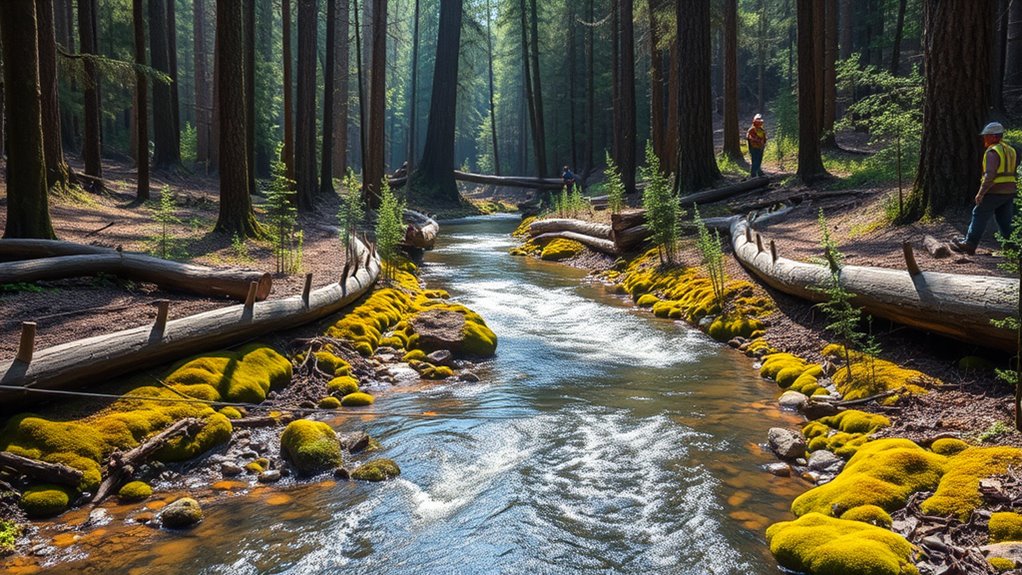
Have you ever wondered how ecosystems bounce back after logging activities? Restoring habitats is essential for waterway health and wildlife survival. You can help by focusing on key actions:
- Creating wildlife corridors that connect fragmented habitats, aiding animal movement and genetic diversity. Wildlife corridors provide safe pathways for animals to access different parts of their range.
- Restoring the canopy to shield the soil, reduce erosion, and promote new plant growth. The canopy also helps maintain the microclimate necessary for various species.
- Replanting native vegetation to rebuild the forest structure and improve water filtration.
- Implementing erosion control measures to protect waterways from sediment runoff.
- Incorporating effective fraud prevention tools in the management of funding and resources dedicated to habitat restoration projects to ensure security and accountability.
Monitoring Water Quality Throughout Operations
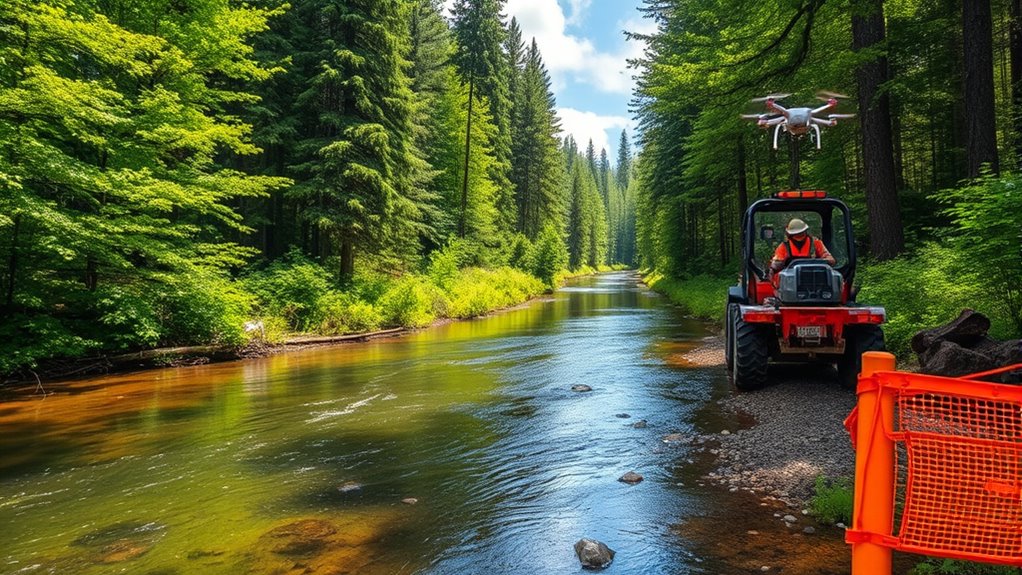
You need to monitor water quality continuously during operations to catch issues early. Implement real-time water sampling and erosion control measures to prevent contamination. Keep detailed data documentation to track changes and guarantee compliance with environmental standards.
Real-Time Water Sampling
How can continuous water sampling enhance the protection of waterways during operations? By providing real-time data, you can quickly detect changes in water quality, allowing immediate action to prevent contamination. Water sampling with monitoring devices helps track parameters like turbidity, pH, and sediment levels consistently. This proactive approach minimizes environmental impact and guarantees compliance with regulations.
- Detect pollutants early before they spread
- Adjust logging activities on the spot
- Maintain regulatory standards effectively
- Protect aquatic ecosystems continuously
With water monitoring tools, you gain vital insights during logging, ensuring your operations stay environmentally responsible. Real-time water sampling empowers you to respond swiftly, reducing the risk of long-term damage and safeguarding waterways throughout your project.
Erosion Control Measures
Monitoring water quality throughout erosion control measures is essential for minimizing environmental impacts during operations. You should regularly assess stream bank stabilization efforts to ensure they effectively prevent erosion and protect waterways. Inspect structures like riprap, bioengineering, and retaining walls for stability and performance. Sediment trapping devices, such as silt fences and sediment basins, must be watched closely to confirm they are functioning correctly and trapping runoff before it reaches water bodies. If sediment accumulates or flow bypasses these barriers, take immediate action. Consistent monitoring allows you to identify issues early, reducing sediment runoff and maintaining water quality. By actively supervising these erosion control measures, you help safeguard aquatic habitats and keep waterway protection efforts effective throughout logging operations.
Data Documentation Procedures
Effective data documentation is essential for tracking water quality throughout erosion control operations. Accurate records help you identify issues early and ensure compliance with environmental standards. To maintain data accuracy, follow consistent documentation standards, recording measurements precisely and promptly. You should:
- Use standardized forms and templates for data entry
- Clearly label sampling locations and times
- Regularly calibrate testing equipment for reliable results
- Review data entries for completeness and correctness
Collaborating With Stakeholders for Responsible Practices
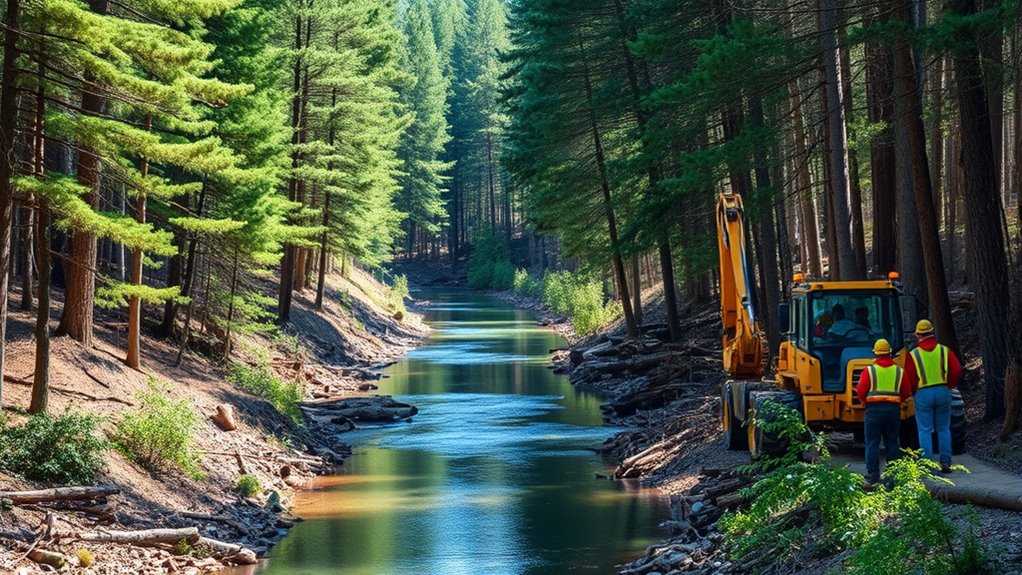
Collaborating with stakeholders is essential for guaranteeing responsible waterway management. Your active engagement with local communities, environmental groups, and industry representatives fosters trust and shared responsibility. By involving stakeholders early, you can gather diverse perspectives that inform effective policy development, reducing conflicts and promoting sustainable practices. Regular dialogue helps identify potential risks to waterways and develop practical solutions that balance economic needs with environmental protection. Clear communication ensures everyone understands their role in safeguarding water quality during logging activities. When stakeholders collaborate, it’s easier to create policies that reflect collective priorities, ensuring responsible practices are consistently followed. This teamwork ultimately enhances waterway resilience, minimizes ecological impacts, and supports long-term sustainability.
Frequently Asked Questions
How Do Different Tree Species Impact Waterway Health During Logging?
Different tree species influence waterway health through their unique water use and root systems. Fast-growing species like pines may deplete nearby water sources, negatively impacting waterway flow. In contrast, broadleaf trees with extensive root systems can stabilize soil and prevent erosion, protecting water quality. Your choice of tree species during logging considerably impacts waterway health, as some species help preserve water quality, while others may cause increased sedimentation and runoff, harming aquatic ecosystems.
What Are the Legal Penalties for Waterway Violations in Logging Areas?
Imagine the weight of legal consequences hanging over you like a storm cloud. If you violate waterway protection laws, you face serious penalties. Penalty enforcement is strict, including hefty fines, logging restrictions, or even jail time in severe cases. These laws aim to safeguard waterways, and ignoring them risks damaging ecosystems. Stay compliant, because the legal consequences are clear, and enforcement is rigorous, ensuring responsible logging practices protect our essential water resources.
How Can Technology Improve Waterway Protection in Forestry Operations?
You can improve waterway protection by leveraging technology like remote sensing and automated monitoring systems. Remote sensing allows you to track changes in land and water quality in real-time, helping you identify potential issues early. Automated monitoring provides continuous data on water parameters, enabling swift response to pollution or erosion. Using these tools, you can proactively manage your forestry operations, minimize environmental impact, and guarantee compliance with water protection standards.
What Training Is Available for Loggers on Waterway Conservation?
Did you know that nearly 60% of loggers participate in waterway conservation training? You can access various certification programs and safety workshops designed to enhance your skills and knowledge. These programs teach best practices for protecting waterways, reducing environmental impact, and ensuring safe logging procedures. By taking advantage of these opportunities, you not only improve safety but also contribute to sustainable forestry and waterway preservation.
How Do Climate Changes Influence Waterway Management in Logging Zones?
Climate changes considerably influence waterway management in logging zones by altering the water cycle, leading to more intense storms and unpredictable rainfall. You need to focus on climate adaptation strategies that help maintain water quality and prevent erosion. By adjusting your practices, such as implementing better drainage and preserving riparian zones, you can protect waterways from the impacts of a changing climate and ensure sustainable logging operations.
Conclusion
By safeguarding waterways, you’re nurturing the lifeblood of the forest, ensuring it continues to breathe and thrive. Think of responsible logging as tending a delicate garden—you must water, prune, and protect to see it flourish. When you implement these practices, you’re not just cutting trees; you’re weaving a resilient tapestry of nature’s harmony. Keep your efforts steady and mindful, and you’ll help the forest sing its song for generations to come.
